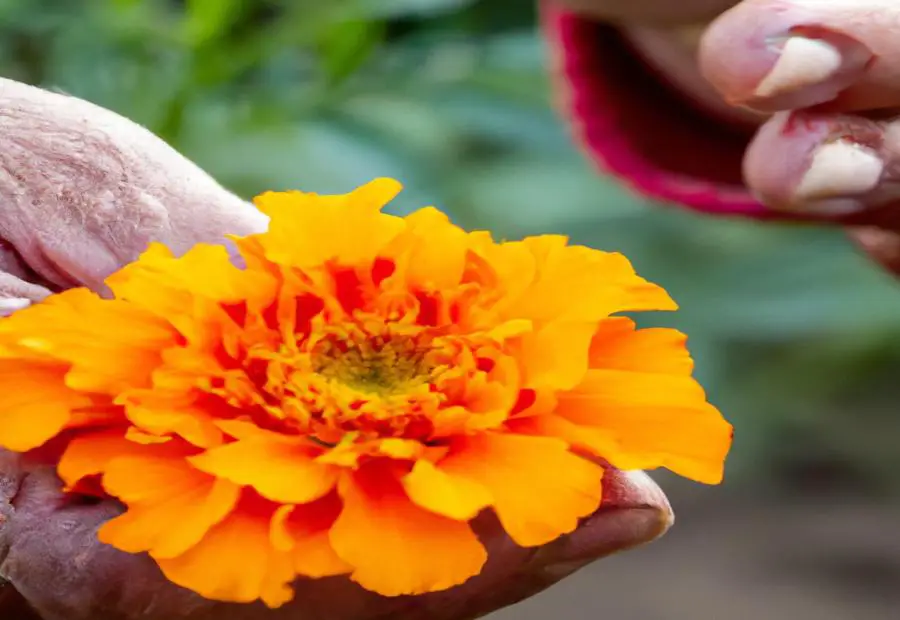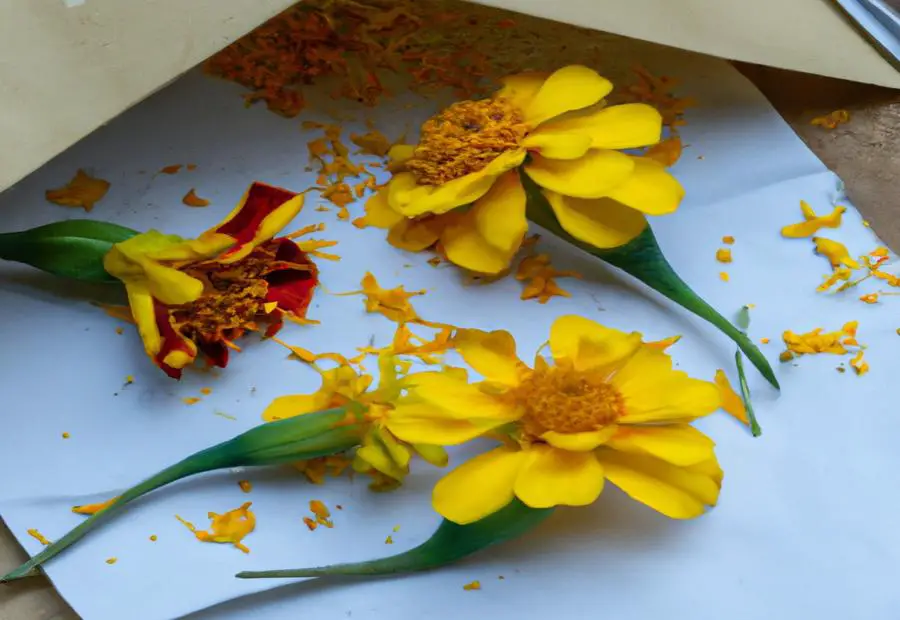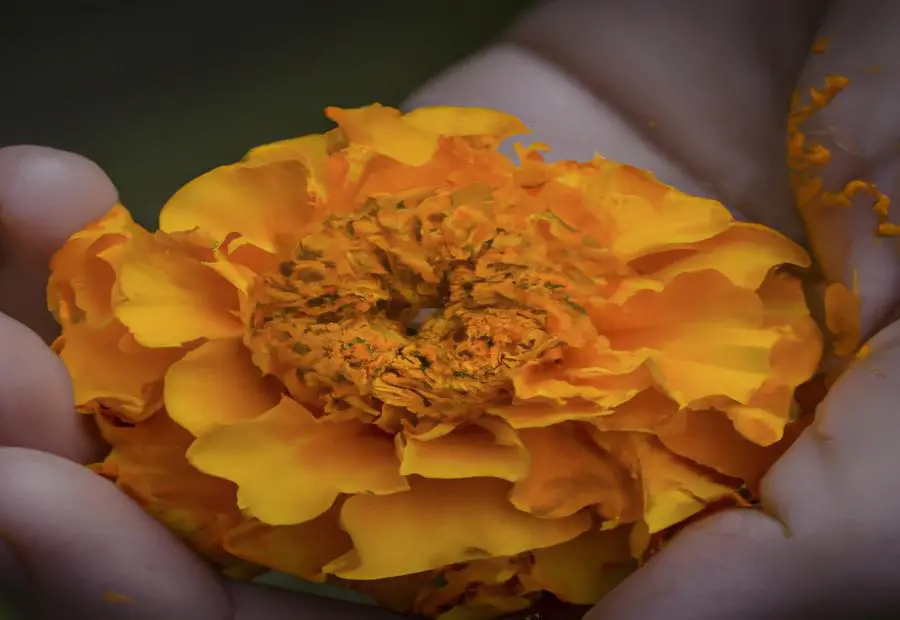Key Takeaways:
- Harvesting and saving Marigold seeds allows for the preservation and propagation of desired varieties.
- Saving Marigold seeds offers the benefit of cost savings, as well as the ability to grow a large number of plants from a single seed source.
- To harvest Marigold seeds, it is important to select the best flowers, dry the flowers for seed collection, and properly store the harvested seeds.
Introduction to Harvesting and Saving Marigold Seeds

Photo Credits: Fortheloveofgardeners.Com by Christopher White
Harvesting and saving marigold seeds can be a rewarding endeavor for any gardener. In this section, we’ll explore why it’s essential to collect and store these precious seeds, and the numerous benefits that come with saving marigold seeds. By understanding the importance and advantages of this practice, you’ll be equipped with valuable knowledge to enhance your gardening experience. So, let’s dig in and discover the world of harvesting and saving marigold seeds!
Why harvest and save Marigold Seeds
Harvesting and saving Marigold seeds is worth it for many reasons! It helps save money and preserve certain varieties that might not be available elsewhere. It also boosts self-sufficiency and sustainability in gardening. Passing down heirloom varieties through generations keeps their unique traits alive.
Plus, Marigold seeds have awesome qualities to make them desirable for collection. They’re relatively large compared to other flower seeds, and have a long viability period when stored correctly. Labeling packets makes it easy to organize and identify seeds when planting.
Gardeners can enjoy the vibrant colors and unique traits of Marigolds while also gifting or exchanging the saved seeds with others. It’s an incredibly rewarding experience, offering a connection to nature. Start saving Marigold seeds and never worry about buying flowers for your ex again!
Benefits of saving Marigold Seeds
Saving marigold seeds has numerous benefits! Keep a continuous supply of plants without the need to buy new ones every year. Preserve hard-to-find varieties and save on costs too.
- Marigold seeds are genetically diverse, producing a range of flower colors, shapes, and sizes.
- Store the best flowers from your garden for future generations.
- Grow marigolds with desirable traits like stronger stems, larger blooms, or increased pest resistance.
- Preserve biodiversity by promoting heirloom varieties and local plant adaptations.
- Share your favorite varieties with other gardeners or friends.
- Enjoy a rewarding experience that deepens your connection with nature and the cycle of life.
Additionally, have control over seed quality and viability. Store them properly in labeled containers to maintain freshness and prevent cross-contamination. Maximize seed viability and maintain genetic integrity.
Marigold seeds: Little miracles bringing sunshine to your garden!
Understanding Marigold Seeds and Their Characteristics

Photo Credits: Fortheloveofgardeners.Com by Austin Rodriguez
Marigold seeds are fascinating! They have distinct traits that help them grow and spread. These seeds are unique and important in gardening and agriculture. It helps to understand their characteristics.
- Appearance: Marigold seeds are small, slender, curved/oblong and brown/black with a smooth/wrinkled texture.
- Size: These seeds are 1-2mm in diameter, making them easy to handle and sow.
- Germination Time: Marigold seeds sprout in 5-7 days after sowing.
- Seed Viability: Marigold seeds remain viable for up to 5 years if stored well.
- Seed Dispersal: Wind, water, animals carry away the seeds to colonize new areas.
- Seed Storage: Store harvested marigold seeds in a cool and dry place to maintain their viability.
Notably, marigold plants deter pests, making them valuable. Plus, their vibrant and varied flower colors are reflected in the seeds, resulting in a diverse range of seeds. These additional aspects add to the significance of marigold seeds in horticulture and seed-saving.
When to Harvest Marigold Seeds

Photo Credits: Fortheloveofgardeners.Com by Alan Wright
Timing is key for harvesting marigold seeds! When the flower heads on the plants have turned brown and dried up, they are ready for harvest.
- Step 1: Search for the dried and brown flower heads.
- Step 2: Gently pinch the base of the flower head and pull it off.
- Step 3: Separate the seeds by rubbing the flower head between your fingers or using a clean, dry cloth.
Store the harvested marigold seeds in a cool, dry place in an airtight container.
Don’t harvest too early when the flower heads are still green or too late when they start to open and disperse. Harvesting at the right time guarantees full maturity and germination when planted.
Be sure to monitor flower heads for the perfect time to harvest! With proper timing, you will be rewarded with a bounty of marigold plants!
How to Harvest Marigold Seeds:

Photo Credits: Fortheloveofgardeners.Com by Brandon Miller
When it comes to harvesting marigold seeds, there are key steps to follow. Learn how to select the best flowers, dry them properly, and remove the seeds from the flower heads. Discover the importance of storing the harvested seeds correctly. Master the art of marigold seed harvesting with this comprehensive guide.
Selecting the Best Flowers for Harvesting
Gardeners must choose the best flowers for harvesting top-notch marigold seeds. They should look for vibrant colors, strong stems, large blooms, pest resistance, and disease resistance. A table can be made to classify these features. To maintain genetic diversity, heirloom or open-pollinated varieties should be prioritized. By observing key plant characteristics, gardeners can guarantee a successful harvest and high-quality seed collection.
Drying the Flowers for Seed Collection
Marigold flowers must be dried to collect their seeds. Drying them is vital for seed collection; it keeps the seeds’ quality and viability. Perfectly dried flowers guarantee the seeds are ripe and suitable for storage.
Here’s a guide on how to dry marigold flowers for seed collecting:
- Pick the best flowers (explained above). Take off any extra leaves and trim the stems to about one inch long.
- Gather the stems and tie them together with a rubber band or string.
- Find a warm, well-ventilated spot to hang them upside down. It could be a dark room or a shady spot outside.
- Hang them securely on a clothesline, hanger, or other suitable support.
- Let the flowers air dry completely. This might take several weeks, depending on the temperature and humidity.
- Once they are dry and crispy, take them down and squeeze each flower head over a clean container to release the seeds.
By following these steps, you can harvest and save marigold seeds without ruining their quality or viability.
Unique Details:
It’s essential to harvest marigold flowers for drying when they are at their peak of maturity but before they start losing petals. This ensures the seeds inside are mature while still being enclosed in the flower heads.
True Fact:
According to “The Complete Guide to Harvesting and Saving Marigold Seeds,” indoor drying of marigold flowers is better than outdoor drying. This provides better control over the drying process and reduces the risk of damage or loss because of the elements.
Removing the Seeds from the Flower Heads
Harvesting and saving marigold seeds requires knowing the right way to remove them from the flower heads. Here’s a step-by-step guide:
- Pick mature flowers with brown or faded petals.
- Hang the flower heads upside down in a dry, ventilated area for two weeks until crispy.
- Rub or sieve the flower heads to separate the seeds from the petals and other debris.
- Use a small fan or blow to rid the seeds of any remaining plant material.
- Put the harvested seeds in a fine mesh strainer and rinse off impurities with running water.
- Spread out the cleaned seeds on paper towel or plate and let them air dry for a few days.
- Store them in an airtight container in a cool, dark place.
Handle the marigold seeds with care to avoid damage or loss of viability. Proper seed collection ensures high seed viability over time.
Properly Storing the Harvested Seeds
Airtight containers, such as glass jars or plastic seed storage bags, are essential for keeping harvested marigold seeds viable and of good quality for future use. Keep these containers in a cool, dry place, like a pantry or basement. Label each one with the variety of marigold and the date of harvest. Avoid exposure to light. Check for pests or diseases before storing – discard any infected or damaged ones. Doing this extends the shelf life of the seeds and ensures they will germinate when planted. It’s like saving money, but with a beautiful reward!
Tips for Successful Marigold Seed Saving:

Photo Credits: Fortheloveofgardeners.Com by Brian Martinez
For successful marigold seed saving, it’s crucial to master a few key tips. We’ll cover everything you need to know, from properly labeling and organizing your seeds to maintaining their viability and quality. Plus, we’ll explore the importance of avoiding cross-pollination to ensure the purity of your marigold seeds. Get ready to become a pro at harvesting and saving marigold seeds!
Labeling and Organizing the Seeds
Labeling and organizing marigold seeds is key for saving them. Clear labels, categorization, and proper storage ensure that the seeds can be easily identified and used effectively later. Here are three steps to take:
- Mark Clearly: Use a permanent marker to label each variety of seed. Write the name, color, and harvest date on small plastic bags or envelopes.
- Group Similar Varieties: Arrange the seeds alphabetically or based on color, size, or other criteria.
- Store Safely: Put the packets in a cool, dry place out of direct sunlight. Use an airtight container or bag to protect the seeds from moisture and pests.
Organizing and labeling marigold seeds makes it easy to identify and share with others who may want to grow them. Follow these steps for successful future use in gardening.
Maintaining Seed Viability and Quality
Seeds are alive with a limited life-span. To maximize marigold seed viability, certain techniques should be followed. For example, store in a cool and dark place. Control humidity to stop moisture buildup and mold growth. And test germination rates regularly.
Also, avoid contamination. Pests and diseases can spread if pollen from different marigolds mix. So, separate varieties by distance or use physical barriers.
Inspect stored seeds for damage or insects. Any damaged or infested seeds should be removed quickly.
With these practices, seed viability and quality can be maintained. This leads to successful germination and strong plant growth.
Avoiding Cross-Pollination
To avoid cross-pollination, it’s essential to maintain the genetic purity of marigold seeds. Here’s a 3-step guide:
- Select distinct marigold varieties with different physical characteristics.
- Create physical barriers between plants – space them apart or use netting.
- Manage flowering times – stagger planting and flowering periods.
Unique details: watch for pollen contamination from neighboring gardens and wildflowers. And remove any volunteer marigold plants from previous years’ blooms. Follow these strategies to ensure success in saving and preserving marigold seeds! Unleash the power of these seeds in your garden!
Using Marigold Seeds:

Photo Credits: Fortheloveofgardeners.Com by Zachary Gonzalez
Discover the endless possibilities of using marigold seeds to enhance your gardening experience. From planting marigold seeds in your garden to starting them indoors, this section provides invaluable insights into harnessing the potential of these remarkable seeds. Explore the benefits of companion plants and seedlings, as well as how you can share the abundance of marigold seeds with fellow gardening enthusiasts. Let’s unlock the secrets of marigold seeds and take your gardening endeavors to new heights.
Planting Marigold Seeds in the Garden
Marigold seeds can be sowed with ease! Just follow the 6-step guide:
- Start off by preparing the soil. Weed out any unwanted plants and loosen it up with a garden fork.
- Then, make small holes or furrows in the soil with your finger or a small tool.
- Pop the marigold seeds in the holes, making sure to space them apart properly according to the seed packet.
- Cover the seeds with soil nicely and pat it down.
- Thoroughly water the newly planted seeds, but not too much.
- Lastly, make sure they get enough sunlight and water for healthy growth.
When choosing a spot to plant Marigold seeds, take into account the environment. Marigolds flourish in full sun and well-drained soil, so pick a place in your garden that fits the bill. Monitor and adjust the watering frequently, depending on the weather.
Plus, Marigolds do more than look pretty. They attract bees and butterflies, which are essential for pollination. Moreover, their pungent aroma deters pests from harming nearby plants.
Starting Marigold Seeds Indoors
Start Marigold Seeds Indoors: 4 Steps.
- Select seeds: Choose matured dried flower heads, collect seeds and discard any damaged and discolored ones.
- Prepare trays or pots: Fill containers with a well-draining soil mixture, leaving 1/4 inch of space at the top for watering. Moisten soil before planting.
- Plant the seeds: Put 2-3 seeds in each container, press them gently into the soil without covering. Water lightly after planting.
- Create ideal environment: Give consistent warmth and moisture by covering the containers with plastic wrap or using a propagator. Put them in a bright location, away from direct sunlight. This helps prevent damping-off disease. Keep the soil moist with misting bottle or bottom-watering method. Additionally, keep the temperature around 70°F (21°C) to promote germination within 7-14 days.
Note that marigolds prefer direct sunlight once they have sprouted. Acclimatize them to outdoor conditions slowly before transplanting into the garden.
Marigolds are often used as companion plants in vegetable gardens to help deter pests such as aphids and nematodes due to their strong smell.
Finding the right companion plants for your marigolds is like setting them up on a horticultural blind date.
Companion Plants and Seedlings
Marigold seeds have many uses! Planting them near tomatoes, peppers, and cabbage can help repel harmful insects, reducing the need for chemical pesticides. Plus, they can act as a trap crop for aphids and nematodes, protecting other crops.
In addition, marigold seedlings make excellent soil for starting other plants indoors. Their biofumigation properties suppress soil-borne diseases, which makes them an ideal choice for growing seedlings.
Moreover, marigolds offer many options for companion planting. They can deter aphids and black spot disease when planted near roses, attract beneficial insects when planted near beans, repel Colorado potato beetles, deter cucumber beetles, help control squash bugs and vine borers, and disrupt the lifecycle of nematodes that attack carrot roots.
Did you know there are over 50 species of marigold? If you’re interested in learning more, check out “The Complete Guide to Harvesting and Saving Marigold Seeds”. Or, why not share the gift of potential floral domination with someone special?
Sharing Marigold Seeds with Others
Share marigold seeds with others and spread the beauty! This can contribute to the growth of these vibrant flowers in different gardens and landscapes.
Gifting or trading seeds promotes biodiversity, preserves marigold varieties, and fosters a sense of community among gardeners. Plus, it’s a sustainable practice that reduces the need for purchasing new plants or seeds.
Sharing marigold seeds is an opportunity to inspire others to discover the joy of gardening and connect with nature. It’s also a way to pass on environmental consciousness and sustainable practices.
Conclusion and Further Resources

Photo Credits: Fortheloveofgardeners.Com by Elijah Taylor
The guide on harvesting and saving marigold seeds can help gardeners keep their flowers vibrant in future seasons. Here are the steps to follow:
- Cut the seed heads off and put them in a paper bag.
- Allow a few days for the seeds to separate from the flowers.
- To maintain the viability of the seeds, store them properly in airtight containers in a cool, dark place.
- They can remain viable for up to 3 years.
The guide suggests exploring additional articles and websites related to gardening. Plus, it suggests reaching out to local communities for tips and advice. This can help gardeners expand their knowledge and skills.
Sarah shared her success story. She followed the guide’s instructions and harvested a good amount of marigold seeds. She was pleased with saving money and being able to share the seeds with fellow gardeners. Her experience shows how the guide can help gardeners become more self-reliant and share with the gardening community.
Some Facts About The Complete Guide to Harvesting and Saving Marigold Seeds:
- ✅ Marigold seeds can be saved and replanted for future growing seasons. (Source: Team Research)
- ✅ Marigolds are easy to grow and are a great choice for gardeners of all experience levels. (Source: Team Research)
- ✅ Harvesting marigold seeds involves waiting until the flower blooms are dry and brown. (Source: Team Research)
- ✅ To harvest marigold seeds, pick faded blossoms and remove the seeds from the stem. (Source: Team Research)
- ✅ Marigold seeds should be stored in a cool, dark, and dry place for future use. (Source: Team Research)
FAQs about The Complete Guide To Harvesting And Saving Marigold Seeds
What is the best season to harvest marigold seeds?
The best season to harvest marigold seeds is at the end of the flowering season, when the flowers are healthy and fertilized.
How do I harvest marigold seeds?
To harvest marigold seeds, wait until the petals are dry and the base of each bloom is turning brown. Cut the flower head a few inches down the stem to avoid damaging the seeds. Pinch the withered petals between your thumb and index finger while holding the base of the flower head with your other hand. Gently pull your hands in opposite directions to remove the petals and reveal the seeds.
How should I store marigold seeds?
After collecting the seeds, let them dry for a day or so before storing them. It is recommended to use a paper envelope for storage to allow any excess moisture to escape. Store the dried seeds in a cool, dark, dry place, such as a glass jar, paper envelope, seed packet, or brown paper bag.
Can I save hybrid marigold seeds?
Yes, you can save hybrid marigold seeds, but the resulting flowers may not look identical to the parent plant. Hybrid marigolds produce flowers that vary, so the next generation of flowers may have different appearances.
How long can marigold seeds be stored?
Marigold seeds can last up to 2 years if stored properly in a cool, dry place. However, the quality of the seeds may degrade over time, so it is recommended to use fresh seeds for each planting season.
Why should I save marigold seeds?
Saving marigold seeds allows for a bountiful harvest and preserves the unique characteristics of each variety. It is a cost-effective and sustainable way to grow marigolds, and it can also be a fun and rewarding gardening activity.

A passionate gardener and founder of ForTheLoveOfGardeners.com. She shares her expertise to help you cultivate thriving gardens and find joy in the beauty of nature.

